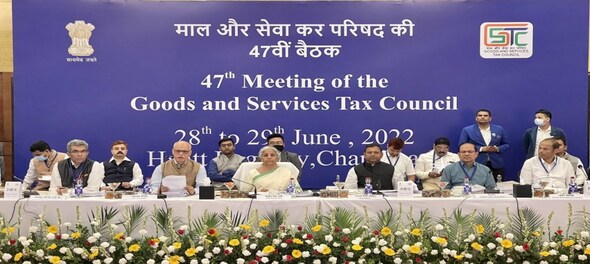
Yet another meeting of that institution, an 'embodiment of pooled sovereignty', the GST Council, has come to an end. This was the 47th meeting of the Council and was being held on the eve of the 5th anniversary of the introduction of the Goods and Services Tax (GST). There were two elephants in the room — the continuation of compensation cess and the fallout of the recent Supreme Court decision regarding the nature of the Council's recommendations. While the first was discussed perfunctorily, the second was not even on the agenda.
On the issue of compensation, while most sought an extension, some states reportedly stated it was no longer required. The finance minister in her inimitable style did mention that the concern of the States was heard. However, no decision was taken — thus for now ending a cess levied on goods consumed by 'sinners' to compensate for the loss. It may be noted that cess will continue to be collected until March 2026 for a different purpose — to pay back the loan extended to the states. No decision regarding the levy or otherwise of GST on cryptocurrency has also been taken.
Having said that the meeting did take several critical decisions based on reports submitted by specific GoMs. Thus, there was rate rationalisation which basically meant cutting down some exemptions and the correction of the inverted duty structure on some goods and services, directions given to GSTN on IT-related matters and on the e-way bill movement of precious metals. The GoM on online gaming and casinos has been given an extension. The issue relating to the convergence of rates is to be examined later.
Anniversaries are also an opportune time for appraisals. India has seen very few tax reforms as sweeping as GST. This was a reform that almost everybody agreed was needed. Paradoxically, there are also very few tax reforms that faced as much criticism as the GST.
However, even its worst critic will admit that GST has done well. Yes, there are rough edges. But the GST Council has sought to address these concerns — on average the Council has met nearly nine times a year. It has to continue to play a critical role — of hearing the voices, of persuading and being persuaded. It must bridge the trust deficit.
Road ahead
Going forward, there should not be too much burden of revenue on GST. Revenue in any tax regime is a function of the tax base and the rate. Revenue growth will be a natural corollary. And GST revenues have been doing well. The tax base has to be expanded. The inclusion of at least some petroleum products can be explored as also electricity and land. The aim ultimately should be to include all supplies within the GST chain.
There has to be a gradual move towards convergence of rates. And not at 'one fell swoop' but gently to reach the pre-GST weighted average rate of 14.8 percent from the present 11.8 percent. The process of reducing exemptions has commenced and should continue. Exemptions break the credit chain and add to costs. Inverted duty structures are also aberrations — corrections here are more challenging but necessary.
The issue of continuing the compensation cess as a guarantee for loss of revenue because of implementation of GST beyond the five-year period needs a finality. It has only resulted in the States becoming fiscally complacent. Ideally, it should not be extended — but if extended the rate has to be a more realistic 8-10 percent. The call will be political.
An area of concern in any tax administration is dispute resolution — it has to be time-bound, consistent with law and with clear channels of appeal. There is an urgent need for establishing the much-delayed GST Tribunal. The decision to constitute a GoM is welcome.
MSMEs are the backbone of the economy. The decision taken in this meeting to permit composition taxpayers to supply through e-commerce operators is a step in the right direction. MSME and the export sectors will continue to need a benign eye.
GSTN the technology network has a key role to play. It has settled down after the initial glitches. The focus on technology should continue relentlessly; the USP of GST is that it is technology-driven. The effort should be to make compliance easy.
Any tax regime is as good as how it is administered. The need for regular and constant training of tax personnel cannot be overemphasised. Training should focus on changes in attitude as much as on technical aspects — we cannot look at taxpayers as adversaries. Having said that we cannot have a tax system where the taxpayer can afford to evade taxes with impunity. Enforcement driven by data analytics should continue as also focussed audits.
GST has more than lived up to its promise. And if ever a validation was required that the Indian business is happy with the GST tax administration it was provided by the recent survey carried out by Deloitte. Ninety percent of Indian CXOs across key sectors have backed 'this dynamic and technologically driven indirect tax regime' which has 'made doing business easy and effective for both businesses and taxpayers'.
There can be no better endorsement.
— Najib Shah is a former chairman of the Central Board of Indirect Taxes & Customs. Views expressed here are personal.
(Edited by : Ajay Vaishnav)
First Published: Jun 30, 2022 3:43 PM IST
Check out our in-depth Market Coverage, Business News & get real-time Stock Market Updates on CNBC-TV18. Also, Watch our channels CNBC-TV18, CNBC Awaaz and CNBC Bajar Live on-the-go!


Andhra Pradesh Lok Sabha elections: A look at YSRCP candidates
Apr 25, 2024 6:54 PM
Lok Sabha elections 2024: Banks and schools to remain closed in these cities for phase 2 voting
Apr 25, 2024 5:33 PM
Andhra Pradesh Lok Sabha elections: Seats, schedule, NDA candidates and more
Apr 25, 2024 5:16 PM

